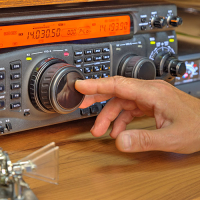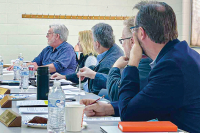In the land of water and rock
 Like Old Esdras in the Bible, some live in a land of milk and honey. Here in the Blue Ridge, we live in the land of water and rock. Moving water and worn stone are the predominant features in our terrain. Landscapes here were not sculpted by wind. They have been — and are being — eroded into and out of existence as the underlying rock slowly accommodates water.
Like Old Esdras in the Bible, some live in a land of milk and honey. Here in the Blue Ridge, we live in the land of water and rock. Moving water and worn stone are the predominant features in our terrain. Landscapes here were not sculpted by wind. They have been — and are being — eroded into and out of existence as the underlying rock slowly accommodates water.
Our language is laden with words and phrases used to describe moving water or its effects: spring, branch, creek, fork, prong, wash, river, stream, waterway, watercourse, watershed, waterfall, eddy, run, pothole, water gap, water table, and so on. The Cherokee and the early settlers assigned these entities beautiful names: Hazel Creek, Healing Springs, Brightwater Branch and Rainbow Falls as well as rivers like Oconaluftee, Tuckaseigee and Cullasaja.
We speak of rock walls and rock falls, rock salt and rock streams, bedrock and rock terraces, rock houses and rock shelters, rock faces and rock slides, and so on. We have a Rock Camp Branch, a Rock Knob Creek, and a Rocky Springs. In Haywood County the two elements are combined in the elegant place name of Shining Rock Creek.
There is, of course, an unavoidable spiritual association with water and rock … either alone or when combined. Mountain paths always wind down to water. And everyone has listened as the stones in a creek bed sing in praise of water. Churches bear witness in names like Carttoogeechaye Creek and Little Snowbird Creek, Holly Springs and Living Waters, Tellico and Double Springs, and so on.
Near Bryson City in the national park the ancient Cherokee had what was later described as a Friendship Wall. It was situated in a gap of the lower Thomas Divide (not Deeplow Gap) between the Kituwha Mound site and Deep Creek watershed. Each time someone passed through the gap they placed a rock on the ground. The Tibetans did the same in the Himalayas. Before long there was a rock wall. It was subsequently bulldozed away by authorities. I was told it stood in the way of an improvement project of one sort or another that was itself later abandoned.
Related Items
In the Nantahala Gorge … I won’t say where … there are neat mounds of stone that could without exaggeration be described as cairns. The archeologist Cyrus Thomas examined them in the 1890s and was of the opinion they predated both the early settlers and the more recent Cherokee.
In Cherokee lore the “Little People” are mischievous elf-like spirits whose assigned task is finding lost children. They like to play tricks and mind games. When they have nothing better to do ... which is most of the time ... they dig holes or construct mini-monuments of water-rounded stone. Even the Cherokee themselves hardly ever see the Little People except out of the corners of their eyes.
But if you are in the right frame of mind their stonework is not infrequently encountered alongside a creek or in the bend of a river. These freestanding sculptures are always delicately balanced and carefully aligned with each stone in its proper place. Even when you don’t know the exact message … if there is one at all … they will always give you something to think about.
I remember my friend, the Cherokee storyteller Kathi Littlejohn, remarking years ago that “They play tricks on you so you’ll be forever young in your heart ... because that’s the way of the Little People.”
In other words they made their sculptures of water-rounded rocks to make you smile or laugh out loud at the way things are.
George Ellison wrote the biographical introductions for the reissues of two Appalachian classics: Horace Kephart’s Our Southern Highlanders and James Mooney’s History, Myths, and Sacred Formulas of the Cherokees. In June 2005, a selection of his Back Then columns was published by The History Press in Charleston as Mountain Passages: Natural and Cultural History of Western North Carolina and the Great Smoky Mountains. Readers can contact him at P.O. Box 1262, Bryson City, N.C., 28713, or at This email address is being protected from spambots. You need JavaScript enabled to view it..









